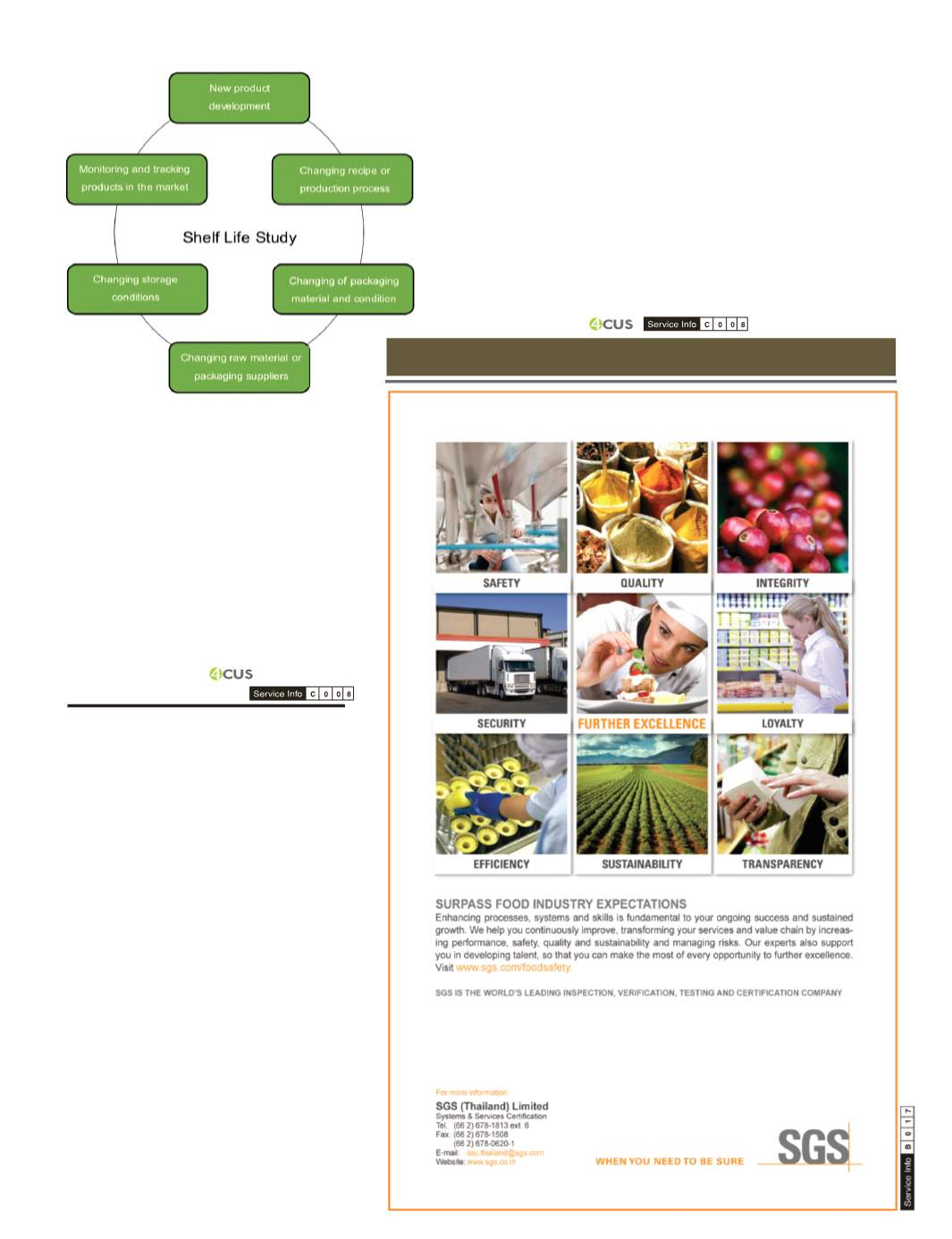
shelf life; nevertheless, shelf life can be estimated or
predicted by use of various orders of kinetic reaction
models. The changes in quality characteristics of
food products mainly change at the zero- or one-
order of reaction. For example, the occurrence of
brown color without using enzymes is a zero-order
reaction, and the growth of microorganisms is a one-
order reaction. In contrast, most of the qualitative
data obtained from the product life testing will be the
quality data obtained from the descriptive sensory
evaluation. This can estimate or predict product
shelf life by using survival analysis, the use of which
is not widespread at present. Furthermore, the study
of shelf life under accelerated conditions needs to
consider the effect of accelerating factors including,
for example, using the Arrhenius equation to study
the effects of temperature and so on.
Thai food regulations require food manufacturers
processing food for sale to specify the shelf life of
the food product on the label. That is the label must
show the date, month, and year for the food product
with a shelf life of not more than 90 days; or show
the date, month, and year, or show month and year
for food with a shelf life longer than 90 days, along
with the required “Best Before” information. This
prevents the producer from avoiding the study of a
product’s shelf life. However, studying the shelf life
of products should not only be undertaken by the
producer when developing new products. It should
also be carried out every time there are changes in
the ingredients or production process, changes in
ส่
งผลต่
อยอดขายของผลิ
ตภั
ณฑ์
ส่
วนการระบุ
อายุ
การเก็
บ
สั้
นกว่
าความเป็
นจริ
ง ก็
จะทำให้
ผู้
ผลิ
ตเสี
ยโอกาสในการขาย
เนื่
องจากผลิ
ตภั
ณฑ์
วางบนชั้
นได้
ไม่
นาน ก็
ล่
วงเลยวั
นหมดอายุ
ที่
ระบุ
บนฉลาก จึ
งต้
องเก็
บผลิ
ตภั
ณฑ์
ออกจากชั้
นวาง
ทั้
งๆ ที่
ยั
งไม่
หมดอายุ
เป็
นต้
น ดั
งนั้
นการระบุ
อายุ
การเก็
บ
ผลิ
ตภั
ณฑ์
จึ
งควรกำหนดให้
เหมาะสม ทั้
งนี้
ต้
องคำนึ
งถึ
ง
ค่
าความปลอดภั
ย (Safety margin) ของผลิ
ตภั
ณฑ์
อาหาร
และควรระบุ
สภาวะการเก็
บด้
วย เช่
น เก็
บไว้
ที่
อุ
ณหภู
มิ
0-4 ํ
C
หรื
อเก็
บไว้
ในที่
แห้
งและเย็
น หรื
อไม่
ควรเก็
บไว้
ในที่
ร้
อนจั
ด
และสั
มผั
สแสงแดด เป็
นต้
น
the type of packaging material or packaging conditions, changes in raw material
suppliers, or changes in storage conditions; even the shelf life of regular products
available in the market needs to be monitored and tracked (Figure 3).
If a manufacturer does not perform shelf life studies for products, and then
specifies inaccurate shelf life for a product, damaging consequences can result. For
example, specifying a shelf life longer than the actual shelf life of a product will result
in product deterioration. This can lead to complaints from consumers or disgruntled
consumers, and will negatively affect the acceptance and sales of the product.
Specifying a shelf life shorter than the actual shelf life will cause manufacturers to lose
sales opportunities; although the product will have been on the shelf only a short time,
it will have passed its labeled expiration date and will have to be removed from the
shelves even though in fact the product has not passed its expiration date. Therefore,
the identification of product shelf life should be proper dating with consideration of
a safety margin of food products. Moreover, the storage conditions should also be
specified, for example, foods need to be stored at 0–4
o
C or stored in a cool and dry
place, and should not be kept in the heat and exposed to the sun, and so on.
Figure 3
Different scenarios requiring study of the shelf life
of food products
เอกสารอ้
างอิ
ง/References
For full lists of references, please directly contact the contributor at


